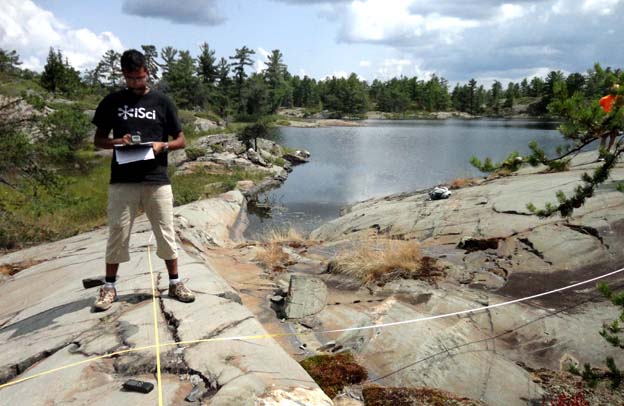Geological formations may hold key to finding water, oil

Integrated Science Program student Prateek Gupta takes ice flow measurements with a compass at Whitefish Falls, Ont. Gupta spent a week studying p-forms, or glacially-sculpted erosional landforms, as part of an Undergraduate Student Research Award project this summer.
Prateek Gupta has a passion for exploring the world beneath his feet.
Gupta, a fourth-year student in McMaster’s Integrated Science Program, spent a week this summer at Whitefish Falls, about an hour southwest of Sudbury, as part of an Undergraduate Student Research Award project.
There, Gupta studied p-forms – troughs, up to 30 metres in length, carved by glaciers out of bedrock.
“I looked at the bedrock formations and tried to figure out what we can learn from these features, and how we can apply what we learn to past glaciations in other areas.”
Because the bedrock at Whitefish Falls is exposed, scientists can study it and learn more about what’s underground in places where bedrock is buried. That could have big implications for the oil and gas, mineral and groundwater industries.
“Erosional features such as p-forms aren’t well represented in glaciological models,” says Gupta, “so by improving these models, we’ll have a better understanding of what’s going on underneath the ground.”
That means making it easier to find aquifers and energy reserves.
“Groundwater is important, oil is important, especially in the west, so if you’re able to start making these connections, there’s a real practical usage to our work.”
For Gupta though, it’s less about the end result, and more about the adventure – which Gupta has had a fair amount of during his undergraduate career.
“I just love exploring the world,” he says.
In May, he and classmates travelled to Iceland to study the Nordic country’s unique geography and geology.
“When we went there and saw glaciers up-close, it made me realize how much they influence the landscape beneath us. In Ontario, we don’t really appreciate how much past events have shaped the landscape. We just see the urban setting and take it for granted.”
Gupta, a recipient of a Charles Murray Ball scholarship in Earth sciences, says being in the Integrated Science Program helps him bridge the gap between the Earth sciences and physics – both of which play a key role in his research, which he presented at the recent Undergraduate Student Research Awards poster session.
